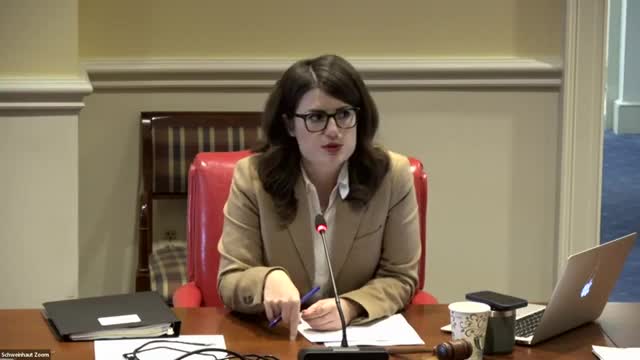Maryland officials outline Chesapeake Bay restoration strategies and budget challenges
January 25, 2024 | Public Safety, Transportation, and Environment Subcommittee, Budget and Taxation Committee, SENATE, SENATE, Committees, Legislative, Maryland

This article was created by AI summarizing key points discussed. AI makes mistakes, so for full details and context, please refer to the video of the full meeting. Please report any errors so we can fix them. Report an error »

In a recent government meeting held on January 25, 2024, Maryland officials gathered to discuss the critical state of Chesapeake Bay restoration and public safety initiatives. The session, led by Andrew Gray, provided a comprehensive overview of the ongoing efforts to improve the health of the Bay, often referred to as its "diet," which aims to reduce nutrient and sediment pollution by 2025.
Gray emphasized the importance of the Total Maximum Daily Load (TMDL) as a regulatory framework guiding these restoration efforts. He outlined the watershed implementation plans and two-year milestones that serve as checkpoints to ensure progress. However, he noted that Maryland has faced setbacks, particularly with wastewater treatment plants, which saw increased pollutant outputs between 2020 and 2021. Encouragingly, 2022 data indicated a slight recovery, but significant work remains, especially in the agricultural sector.
The meeting also highlighted the financial challenges facing restoration efforts. Gray reported a projected decrease of approximately $195 million in funding for Chesapeake Bay initiatives due to reduced transfer tax revenues. This decline raises concerns about the state's ability to meet its restoration goals, particularly as climate change and population growth continue to exert pressure on the Bay's ecosystem.
In response to these challenges, Maryland's Department of Natural Resources (DNR) Secretary Josh Kurtz discussed the administration's commitment to enhancing inter-agency collaboration. He noted the establishment of a Watershed Council to unify efforts across various departments, recognizing that the health of the Bay is intertwined with multiple sectors, including health and transportation.
Secretary of the Environment Serena McElwain echoed this sentiment, emphasizing the need for a renewed focus on environmental justice and community engagement in restoration efforts. She outlined a strategy centered on reinvigorating successful practices, rethinking restoration approaches, and re-engaging communities that have historically been overlooked.
The meeting also touched on specific projects, such as the Conowingo Dam's nutrient reduction plan, which has garnered $25 million in state funding. The dam plays a crucial role in trapping sediment and nutrients, and its management is vital for the overall health of the Bay.
As discussions progressed, the importance of targeted funding and strategic land preservation emerged as key themes. The officials acknowledged that better data and mapping capabilities could enhance the effectiveness of restoration efforts, allowing for more precise allocation of resources.
In conclusion, while the meeting underscored the progress made in Chesapeake Bay restoration, it also highlighted the significant hurdles that lie ahead. The collaborative approach among state agencies, coupled with a focus on community engagement and innovative funding strategies, will be essential as Maryland strives to meet its ambitious environmental goals by 2025 and beyond. The commitment to transparency and accountability in these efforts will be crucial in ensuring the Bay's health for future generations.
Gray emphasized the importance of the Total Maximum Daily Load (TMDL) as a regulatory framework guiding these restoration efforts. He outlined the watershed implementation plans and two-year milestones that serve as checkpoints to ensure progress. However, he noted that Maryland has faced setbacks, particularly with wastewater treatment plants, which saw increased pollutant outputs between 2020 and 2021. Encouragingly, 2022 data indicated a slight recovery, but significant work remains, especially in the agricultural sector.
The meeting also highlighted the financial challenges facing restoration efforts. Gray reported a projected decrease of approximately $195 million in funding for Chesapeake Bay initiatives due to reduced transfer tax revenues. This decline raises concerns about the state's ability to meet its restoration goals, particularly as climate change and population growth continue to exert pressure on the Bay's ecosystem.
In response to these challenges, Maryland's Department of Natural Resources (DNR) Secretary Josh Kurtz discussed the administration's commitment to enhancing inter-agency collaboration. He noted the establishment of a Watershed Council to unify efforts across various departments, recognizing that the health of the Bay is intertwined with multiple sectors, including health and transportation.
Secretary of the Environment Serena McElwain echoed this sentiment, emphasizing the need for a renewed focus on environmental justice and community engagement in restoration efforts. She outlined a strategy centered on reinvigorating successful practices, rethinking restoration approaches, and re-engaging communities that have historically been overlooked.
The meeting also touched on specific projects, such as the Conowingo Dam's nutrient reduction plan, which has garnered $25 million in state funding. The dam plays a crucial role in trapping sediment and nutrients, and its management is vital for the overall health of the Bay.
As discussions progressed, the importance of targeted funding and strategic land preservation emerged as key themes. The officials acknowledged that better data and mapping capabilities could enhance the effectiveness of restoration efforts, allowing for more precise allocation of resources.
In conclusion, while the meeting underscored the progress made in Chesapeake Bay restoration, it also highlighted the significant hurdles that lie ahead. The collaborative approach among state agencies, coupled with a focus on community engagement and innovative funding strategies, will be essential as Maryland strives to meet its ambitious environmental goals by 2025 and beyond. The commitment to transparency and accountability in these efforts will be crucial in ensuring the Bay's health for future generations.
View full meeting
This article is based on a recent meeting—watch the full video and explore the complete transcript for deeper insights into the discussion.
View full meeting
